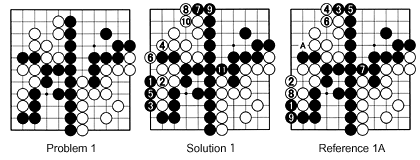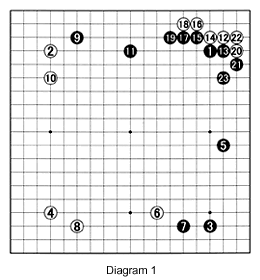Because of her good looks and promotion of go, Umezawa has become something of a celebrity, making frequent appearances on TV programs. She is also one of the few go professionals who has a university degree, having attended Keio University.
The second event, more important for hard-core go fans, was the first game of the best-out-of-seven match for the 26th Kisei title. Challenger Ryu Shikun, who has been stuck as a 7-dan for many years now because he doesn't have time to play in the Oteai league, is a tough opponent for defending titleholder O Rissei.
The Kisei title is sponsored by The Yomiuri Shimbun and carries a winner's purse of 42million-yen. The game is demonstrated after this week's endgame, or yose, problems.
Endgame Tesuji
Problem 1 :Black plays first and wins the game (no komi). Keeping sente (play moves that White has to answer) in combination with a tesuji (clever local move) form the key here.

Solution 1 :
Black 1 is an exquisite endgame tesuji. White's best response is at 2. This allows Black to play the moves to 5 in sente, then switch to 7 through 9 in order to take the last point at 11. This way Black has 29 points against White's 28 points (26 points in territory plus 2 captured stones)-Black wins by 1 point.
Reference 1A :
Black 1 is sente and prevents a White move at 9, but it lacks technique. In the end, White doesn't even have to add a move at A. Black's territory stays the same, but White's territory is a full 4 points larger. White would win by 3 points.
Reference 1B :
Black 1 is slightly better than the Reference 1A variation, but lacks finesse. In this case, White has to capture the two stones, but in addition he also gets to capture black 1. This variation leads to White winning by 2 fewer points compared to the Solution 1 diagram. The result would be a 1-point win by White.
Solution to last week's problem
Solution 3 :Black 1 is the winning move. This is due to the fact that there is only one (reverse) sente move while there are six gote (losing the initiative) situations, with the first two worth 6 points each, the next two worth 5 points each and the last two worth 2 points each. In other words, there are three pairs of situations with each situation in a pair having the same value. Both players are going to get one move out of each pair, and the order of playing the first or the second situation in a pair doesn't matter. But what does matter is the one sente situation. That point is then the only contested one. The score would be a one point win for Black.

Reference 2 :
What happens if Black plays the biggest move by playing at 1 (worth 6 points)? Then White will play 2 to force 3, decreasing Black's territory by 1 point. Next, White switches to 4 (which is also worth 6 points). In the end, it will be a jigo (draw).
In other words, preventing a sente move is often worth more than playing a move that is gote for both sides. We call a move that prevents a sente move from being played a reverse sente.
Ryu Shikun vs O Rissei
Diagram 1 (1-23) :Ryu Shikun has the black stones while O Rissei is White. Among those who are "in the know," the consensus is that O will defend his title successfully. However, Ryu should not be underestimated. At the age of 23 he took the Tengen title, held on to it for a few years, but then "gave in to the temptations of the good life and having fun," in his own words. He was injured in a well-publicized incident in China in December 2000, and in reaction to that, he has once again become committed to playing a major role in the go world.

Ryu likes influence and fighting, and the low Chinese fuseki (1-3-5) are consistent with that intention, while O likes territory-especially playing as White. He often takes points everywhere first, then goes out to destroy the territory of his opponent. The invasion at 12 is an example of his style. White manages to keep sente in the sequence to 23. Where should White play next ?
Diagram 2 (24-50) :
Knowing O's style, white 24 doesn't come as a surprise. An alternative would be capping at 34. The shape that White forces Black into from 26 through 30, is bad, because the marked stone now makes an empty triangle. However, the total result means Black has damaged White's original stone at 6. After 34, the white stones are more or less settled. So Black plays a wariuchi (wedging move that has room for expansion) on the left side with 35 (see Reference 3).

White 36 is forced, but now black 37 takes away White's base. White 38 is the professional approach-White plays tsuke (against the stones) because he doesn't mind if Black gets stronger in this area (since Black is strong already). If Black answers white 38, Black will get stronger, but so will White. The strength White builds up this way can be used to attack black 37 and 35. That explains Black's invasion at 39. The moves to 46 are natural. Even though Black has taken away White's corner and made life-his position is low (four stones on the 2nd line) and insignificant.
However, as he gets sente to play at 47, Black has no reason to be dissatisfied if his attack on the right succeeds. After white 50, how should Black proceed ?
Reference 3 :
Black 1 looks natural, but then white 2 is a good move. Black can make a two-point extension with 3, but White will play 4 through 8. Usually, White has to defend his corner where the marked stone is (or one line higher). But since it is there already, the combination 4 through 8 secures a lot of corner territory while taking away Black's base. Black can defend with a move like 9, but white 10 is just right.

Diagram 3 (1-47) :
Black 1 is a severe attack. White probably played at 2 without even thinking, as this is the shape move, but it did make White heavy. After 5, White is in trouble. Through a clever combination 8 through 18, White managed to escape, but at the great cost of letting Black cut with 19 through 23. However, White 24 through 38 are a good combination that erases Black's territory while stabilizing his own group. White 40 through 44 take a territorial lead, but his stones are still thin throughout the board. Black's last chance is to exploit White's thinness by the attack he launches with 45 and 47. How should White respond ?
Find out the answer next week.
